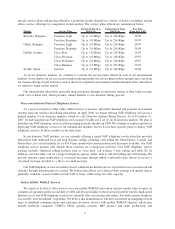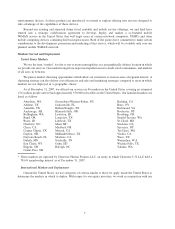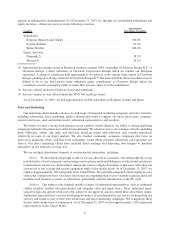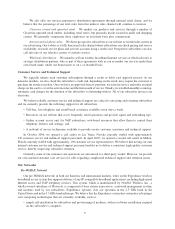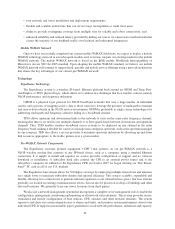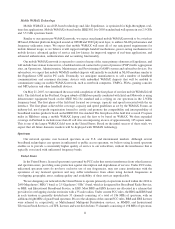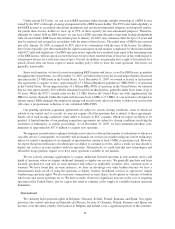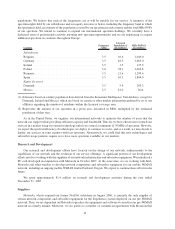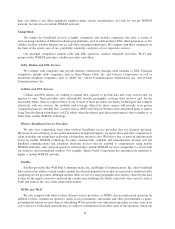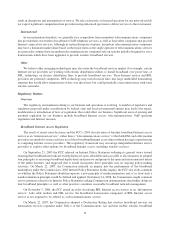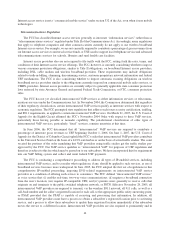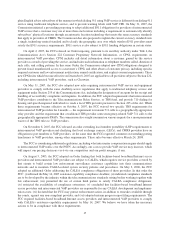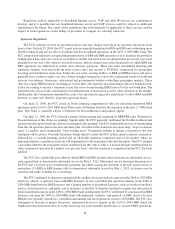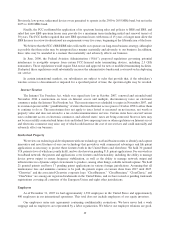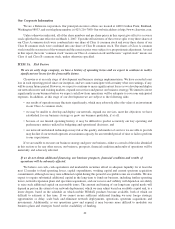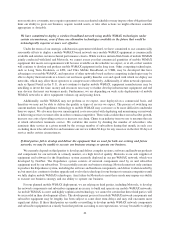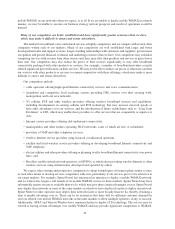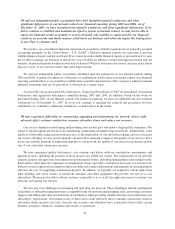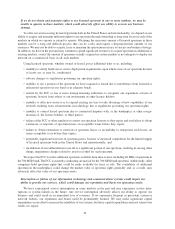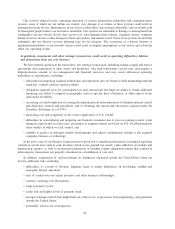Clearwire 2007 Annual Report Download - page 24
Download and view the complete annual report
Please find page 24 of the 2007 Clearwire annual report below. You can navigate through the pages in the report by either clicking on the pages listed below, or by using the keyword search tool below to find specific information within the annual report.Internet access service is not a “commercial mobile service” under section 332 of the Act, even when it uses mobile
technologies.
Telecommunications Regulation
The FCC has classified Internet access services generally as interstate “information services” rather than as
“telecommunications services” regulated under Title II of the Communications Act. Accordingly, many regulations
that apply to telephone companies and other common carriers currently do not apply to our wireless broadband
Internet access service. For example, we are not currently required to contribute a percentage of gross revenues from
our Internet access services to universal service funds, or USF, used to support local telephone service and advanced
telecommunications services for schools, libraries and rural health care facilities.
Internet access providers also are not required to file tariffs with the FCC, setting forth the rates, terms, and
conditions of their Internet access service offerings. The FCC, however, is currently considering whether to impose
various consumer protection obligations, similar to Title II obligations, on broadband Internet access providers,
including DSL, cable modem and wireless broadband providers. These requirements may include obligations
related to truth-in-billing, slamming, discontinuing service, customer proprietary network information and federal
USF mechanisms. The FCC is also considering whether to impose automatic roaming obligations on wireless
broadband service providers similar to the obligations currently imposed on commercial mobile radio services, or
CMRS, providers. Internet access providers are currently subject to generally applicable state consumer protection
laws enforced by state Attorneys General and general Federal Trade Commission, or FTC, consumer protection
rules.
The FCC has not yet classified interconnected VoIP services as either information services or telecommu-
nications services under the Communications Act. In November 2004, the Commission determined that regardless
of their regulatory classification, certain interconnected VoIP services qualify as interstate services with respect to
economic regulation. The FCC preempted state regulations that address such issues as entry certification, tariffing,
and E911 requirements, as applied to certain interconnected VoIP services. On March 21, 2007, the U.S. Court of
Appeals for the Eighth Circuit affirmed the FCC’s November 2004 Order with respect to these VoIP services,
particularly those having portable or nomadic capability. The jurisdictional classification of other types of
interconnected VoIP services, particularly “fixed” services, remains uncertain at this time.
In June 2006, the FCC determined that all “interconnected” VoIP services are required to contribute a
percentage of interstate gross revenues to USF beginning October 1, 2006. On June 1, 2007, the U.S. Court of
Appeals for the District of Columbia Circuit upheld the FCC’s order that interconnected VoIP providers contribute
to the Universal Service Fund on the basis of a 64.9% safe harbor or on the basis of actual traffic studies. The court
vacated the portions of the order mandating that VoIP providers using traffic studies get the traffic studies pre-
approved by the FCC. Our VoIP service qualifies as “interconnected VoIP” for purposes of USF regulation and
therefore is subject to this fee which may be passed on to our subscribers. We have incorporated this fee requirement
into our VoIP billing system and collect and remit federal USF payments.
The FCC is conducting a comprehensive proceeding to address all types of IP-enabled services, including
interconnected VoIP service, and to consider what regulations, if any, should be applied to such services, as use of
broadband services becomes more widespread. In June 2005, the FCC adopted the first set of regulations in this
comprehensive IP-enabled proceeding, imposing E911-related requirements on interconnected VoIP service
providers as a condition of offering such service to consumers. The FCC defined “interconnected VoIP service”
as voice service that: (i) enables real-time, two-way voice communications; (ii) requires a broadband connection
from the user’s location; (iii) requires IP-compatible CPE; and (iv) permits users generally to receive calls that
originate on and terminate to the public switched telephone network, or PSTN. Effective November 28, 2005, all
interconnected VoIP providers are required to transmit, via the wireline E911 network, all 911 calls, as well as a
call-back number and the caller’s registered location for each call, to the appropriate public safety answering point,
or PSAP, provided that the PSAP is capable of receiving and processing that information. In addition, all
interconnected VoIP providers must have a process to obtain a subscriber’s registered location prior to activating
service, and a process to allow their subscribers to update their registered location immediately if the subscriber
moves the service to a different location. Interconnected VoIP providers are also required to prominently and in
16


